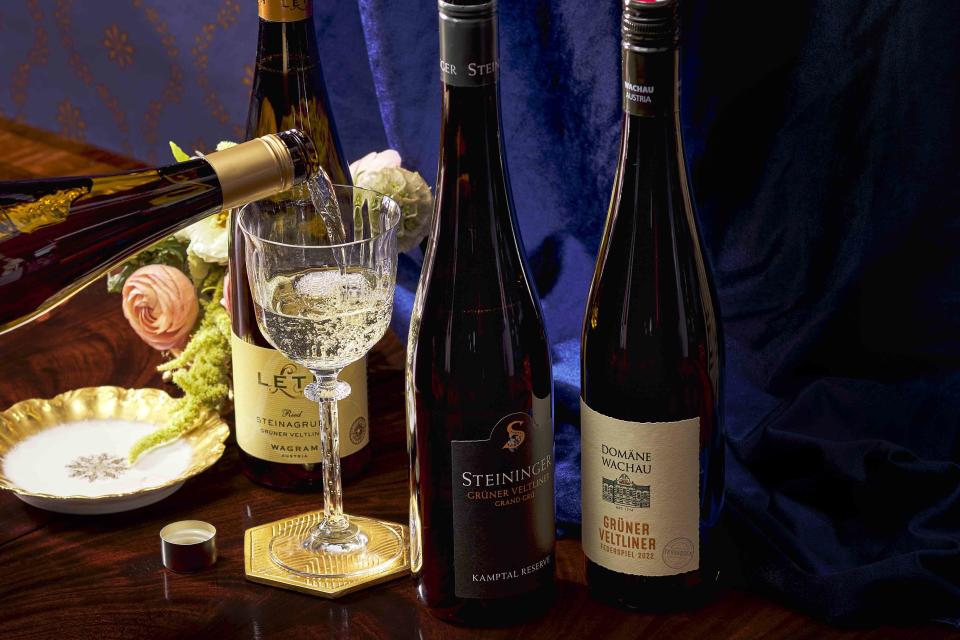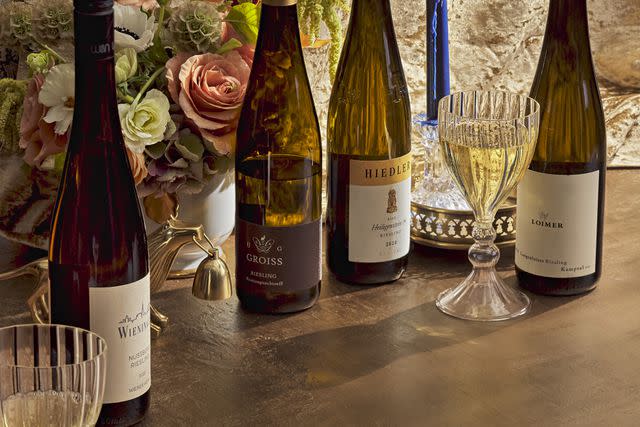13 Austrian Wines That Are Perfect for Springtime
Austrian white wines are the perfect thing to open as the days get brighter and warmer.

Frederick Hardy II / Food Styling by Margaret Monroe Dickey / Prop Styling by Claire Spollen
Although Austria’s Wagram region, just outside of Vienna on the Danube, isn’t as famous as Kremstal or Wachau farther downriver, producers like Leth are drawing attention to it with wines like this floral, grapefruity, effortlessly balanced white.
The way I see it, there’s not much better in life than sitting outside at a Viennese heuriger, or wine café, on a crisp Austrian spring day, under the vine arbors, sipping Grüner Veltliner and snacking on spicy Liptauer cheese and bread. Now, I recognize it is impossible to do that when one is not in Austria; Vienna, no matter how hard one wishes for it to be the case, is not in the U.S. But a porch, a little springtime weather, and a glass of Austrian white make a mighty nice workaround. (You can fake the Liptauer by mashing up cream cheese or quark with a little Hungarian paprika, chopped capers, minced onion, and caraway seeds; a little softened butter never hurts, either.)
And it’s a great time to try the two great white wines of Austria: Grüner Veltliner and Riesling. Winemaker Fred Loimer says, “We’re lucky and happy at the moment — 2021 was a great vintage, 2019 and 2020 were both good, the ’22 Grüners were very good, and the ’22 Rieslings are fabulous.” For me, these are the ideal wines of springtime: Riesling with its mountain-stream clarity of flavor, Grüner with its characteristic light hint of fresh green herbs, in a way recalling the first green shoots of the new season. Here are some favorites to seek out.

Frederick Hardy II / Food Styling by Margaret Monroe Dickey / Prop Styling by Claire Spollen
Grüner Veltliner
2021 Leth Ried Steinagrund Grüner Veltliner ($19)
Although Austria’s Wagram region, just outside of Vienna on the Danube, isn’t as famous as Kremstal or Wachau farther downriver, producers like Leth are drawing attention to it with wines like this floral, grapefruity, effortlessly balanced white.
2022 Domäne Wachau Grüner Veltliner Federspiel ($20)
Domäne Wachau manages almost 30% of the vineyards in the famed Wachau region (a UNESCO World Heritage Site) and makes a bevy of impressive wines from them. The term federspiel designates dry Wachau wines between 11.5% and 12.5% alcohol; this one offers a lot of intensity for the price.
2022 Sepp Moser Grüner Veltliner Von den Terrassen ($24)
Nikolaus Moser is unusual in that he makes wines both in a classical and in a natural style. His traditional von den terrassen Grüner is always a spot-on expression of the variety, its vivid acidity supporting crisp, tree-fruit flavors. (Natural wine fans should try his hazy, orange-scented Minimal Grüner.)
Related: Heading to Vienna? Here Are All of the Places You Should Be Checking Out
2021 Steininger Grand Grü Grüner Veltliner ($30)
Karl and Brigitta Steininger organically farm 135 acres in Austria’s Kamptal region, inland from the Danube. This lovely white suggests orchard fruits with a hint of pineyness; it lingers and lingers on the palate, too. (Plus, the name wins on cleverness points.)
2021 Weingut Knoll Grüner Veltliner Loibner Federspiel ($38)
Emmerich Knoll and his wife, Anja, make some of Austria’s most sought-after wines; look for the dramatic image of St. Urban, the patron saint of grape growers, on their labels. What’s in the bottle is what really matters, though, like this seductively aromatic, pinpoint-precise Grüner.
2021 Ebner-Ebenauer Ried Hermanschachern Grüner Veltliner ($40)
Tingly and zingy, this fragrant Grüner has notes of white pepper, nectarine, and grapefruit peel. Winemaker Manfred Ebner-Ebenauer’s family has been growing vines for 14 generations, and the family’s 400-year-old cellar in Poysdorf is still the source for all of their wines.
Schloss Gobelsburg Tradition 3 Years Edition 851 ($48)
Winemaker Michael Moosbrugger’s “Tradition” project aims at making wines as was done in the early 1800s: fermenting in oak (rare in Austria now), basket-pressed grapes, and blends of vintages. This full-bodied and savory edition blends 80% Grüner and 20% Riesling from 2018, 2017, and 2016.
Riesling
2022 Ingrid Groiss Braitenpuechtorff Riesling ($19)
The Groiss family has farmed grapes in lower Austria for centuries. Today, that work is overseen by the talented Ingrid Groiss. Among the wines she produces is this laser-sharp dry Riesling, its aromas suggesting lemons and spring flowers.
2022 Wieninger Nussberg Riesling ($20)
Located within the city limits of Vienna, Wieninger is known for its traditional Gemischter Satz white blends, but Fritz Wieninger, the owner and winemaker, has an equally deft hand with Riesling. This pretty, lime-zesty dry wine is ample proof of that.
2022 Loimer Langenloiser Riesling ($28)
Fred Loimer is one of the Kamptal region’s top producers, and his wines, from his affordable Lois Grüner to his single-vineyard bottlings, are all excellent. This palate-whetting, sleek white is a stellar dry Riesling, full-bodied yet weightless at the same time.
Related: 17 Rieslings That Show Off Everything the Grape Can Do
2021 Nikolaihof Vom Stein Riesling Federspiel ($40)
Nikolaihof is truly ancient, and as Nik Saahs, whose family owns the winery, once said to me, “How astounding to be in a cellar where 1,800 years ago someone was also filling a cup with wine.” Fill your glass with this Riesling, and you’ll be drinking history.
2019 Salomon Undhof Ried Steiner Kögl Riesling ($45)
Kremstal-based Salomon Undhof was the first Austrian winery to export to the U.S., back in the 1930s; their quality has been uniformly high for decades. This single-vineyard Riesling, rich with melon and pear fruit, complex and lasting, is characteristic.
2022 Hiedler Heiligenstein Riesling ($58)
Hiedler has been family-owned since the mid-1800s, and in 1906, the Archduchy of Austria honored them for their wine’s quality. World War I put an end to the archduchy, but the Hiedlers are still going strong, and this refined, stony white is a knockout.
For more Food & Wine news, make sure to sign up for our newsletter!
Read the original article on Food & Wine.

